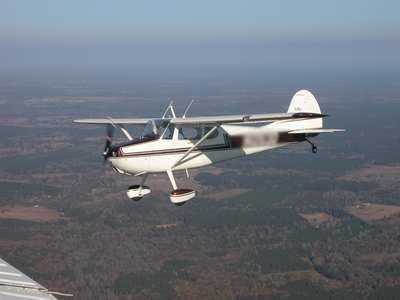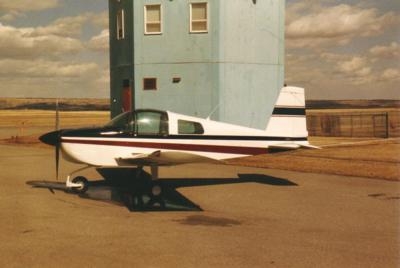Suggests Accident Occurred After Planes Changed Formation In Flight
The NTSB has released its preliminary report from a mid-air collision which occurred April 1 in central Florida. The pilots of the two aircraft involved were fatally injured.

According to the report, a Cessna 170B, N8082D, and a Grumman American AA-5B, N425AE, were destroyed during an in-flight collision near New Smyrna Beach, Florida. The airline transport pilot flying the Cessna and the airline transport pilot flying the Grumman were both fatally injured. The airplanes were part of a formation flight that departed from Spruce Creek Airport (7FL6), Daytona Beach, Florida, about 0839, and was destined for Arthur Dunn Airport (X21), Titusville, Florida. No flight plan was filed. Visual meteorological conditions prevailed, and the personal formation flight was conducted under 14 Code of Federal Regulations Part 91.
Both accident airplanes were participating in a formation flight with three other airplanes. All five pilots participating in the formation flight were members of a pilot group based at 7FL6. On the morning of the accident, members of the group were flying to X21 to attend a monthly breakfast event.
The five-airplane formation flight involved in the accident included a Great Lakes biplane, the accident Cessna, the accident Grumman, a Grumman AA-1C (Lynx), and an American Champion 8KCAB (Super Decathlon), all of which took off from 7FL6 in elements. The flight leader was flying the biplane and the accident Grumman took off in formation first, followed by the Cessna and the Lynx taking off in formation next, followed by the Decathlon. After takeoff from 7FL6, the flight initially formed into a five airplane "Vic" or "V" formation, with the flight leader in the biplane at the apex, and the rest of the flight in echelon with the Grumman in the No. 2 position, and the Decathlon in the No. 5 position, to the left of the flight leader, and the Cessna in the No. 3 position, and the Lynx in the No. 4 position, to the right of the flight leader.
The formation flight then turned south towards X21. Due to the position of the sun, the flight leader decided to change to a left echelon formation where the airplanes would be arranged diagonally, to his left, with each airplane being stacked slightly low, behind, and to the left of the airplane ahead. This arrangement allowed the pilots to avoid the sun glare. This would require the Cessna (No. 3) and the Lynx (No. 4) to transition across from right to left behind the leader. The Grumman would remain in the No. 2 position to the left and aft of the leader, the Cessna in the No. 3 position to the left and aft of the Grumman, the Lynx in the No. 4 position to the left and aft of the Cessna, and the Decathlon in the No.5 position to the left and aft of the Lynx.
According to the flight leader, moments after he commanded the Cessna and the Lynx to the left, in the corner of his peripheral vision at approximately his 7 o'clock position, he saw a "flash" or something white, like the bottom of an airplane.
According to the pilot of the Lynx, when the flight leader commanded the Cessna, and himself to the left, he heard the flight leader transmit "cleared to cross," and he observed the Cessna start to move to the left "slow and normal." He stayed with the Cessna, and when it was almost on the left echelon bearing line, he saw the it move into position behind the Grumman. He then suddenly saw "parts" coming back towards him on his right side, along with what appeared to be "vapor." He then saw the Grumman abruptly pitch up, and go past him above and to his right. The Grumman then looked like it was entering a loop as the airplane's nose was already past vertical and he could see the top of the airplane. He then observed something on the right side of the Cessna move upward before its tail began to "slew to the left," and disappeared from view.
The biplane and the Lynx then broke formation, with the biplane immediately pulling up and turning hard left, and the Lynx entering a left 60° banked turn. The flight leader in the biplane could see parts of the airplanes falling to the ground, and he could see the Cessna descending like a falling leaf with what appeared to be the right wing folded over. The flight leader then began to circle the accident site, and reported the accident over the radio to an air traffic controller at New Smyrna Beach Municipal Airport, (EVB), New Smyrna Beach, Florida. He then continued to circle the accident site until emergency responders arrived.
According to witnesses who were driving on Interstate Highway 95 (I-95), they saw the formation flight traveling southbound. They observed that the formation flight was about 1/4 mile west of I-95 when the collision occurred, and they observed the "wing" on one of the airplanes come off, the airplane tumble, and then rapidly descend tail low, until they lost sight of it behind a tree line. They also saw the other airplane descend rapidly, almost straight down, until losing sight of it. The witnesses also watched as parts from both airplanes descend to the ground with one piece landing in the median between the northbound and southbound lanes. Moments after the collision occurred, another formation flight flew north along the east side of I-95.

Examination of the accident site revealed that a 1/4-mile-long debris field, with most the debris being contained in a 1,036 ft long by 290 ft wide section. The Grumman and Cessna came to rest approximately 220 ft apart.
Examination of the wreckage of the Cessna revealed that the monocoque structure of the aft fuselage was completely separated from the rest of the airplane's structure, just forward of the empennage. The empennage was attached to the rest of the airplane by the control cables for the elevator, rudder, and pitch trim, which were twisted around each other multiple times. Further examination of the aft fuselage and empennage also revealed the presence of paint transfers, which matched the trim color of the Grumman. These were present on the leading edge of the vertical stabilizer which had been crushed back, the right horizontal stabilizer, and the right side of the aft fuselage.
The Cessna's right wing flap came to rest approximately 397 ft northeast of the main wreckage of the Cessna. The inboard section of the right aileron was missing, the right aileron control cable had been severed, and the area of the wing just forward of the right wing flap mounting location, displayed evidence of propeller strikes, and was missing large sections of its structure. Examination of the wreckage of the Grumman revealed that no major portions of the airplane were missing. The leading edges of the propeller blades were damaged and displayed semicircular gouges.
According to FAA and maintenance records, the Cessna was manufactured in 1952. Its most recent annual inspection was completed on October 1, 2016. At the time of the inspection, the airplane had accrued 4596.8 total hours of operation.
According to FAA and maintenance records, the Grumman was manufactured in 1977. Its most recent annual inspection was completed on September 1, 2016. At the time of the inspection, the airplane had accrued 1673.4 total hours of operation.
According to FAA records, the pilot of the Cessna held an airline transport pilot certificate with ratings for airplane multi-engine land, and commercial privileges for airplane single-engine land. He also held a flight instructor certificate with ratings for airplane single engine, airplane-multi engine, and instrument airplane; a flight engineer certificate with a rating for flight engineer turbojet powered; and a mechanic certificate with ratings for airframe and powerplant. He also held type ratings for the B-737, B-757, B-767, B-777, BE-1900, and BE- 300. His most recent FAA first-class medical certificate was issued on February 10, 2017. He had accrued about 14,620 total hours of flight experience.
According to FAA records, the pilot of the Grumman held an airline transport pilot certificate with ratings for airplane multi-engine land, and commercial privileges for airplane single engine land, and airplane single-engine sea. She also held a flight instructor certificate with ratings for airplane single engine, airplane-multi engine, and instrument airplane; a flight engineer certificate with a rating for flight engineer turbojet powered; and a ground instructor certificate with ratings for advanced and instrument. She also held type ratings for the A-330, B-747, B-757, B-767, BE-1900, and CE-510S. Her most recent FAA first-class medical certificate was issued on October 19, 2016. She had accrued about 11,368 total hours of flight experience.
The wreckage of both airplanes was retained by the NTSB for further examination.
(Images from file. Not accident aircraft)
 ANN's Daily Aero-Linx (04.16.24)
ANN's Daily Aero-Linx (04.16.24) Aero-News: Quote of the Day (04.16.24)
Aero-News: Quote of the Day (04.16.24) Airborne 04.10.24: SnF24!, A50 Heritage Reveal, HeliCycle!, Montaer MC-01
Airborne 04.10.24: SnF24!, A50 Heritage Reveal, HeliCycle!, Montaer MC-01 Airborne 04.12.24: SnF24!, G100UL Is Here, Holy Micro, Plane Tags
Airborne 04.12.24: SnF24!, G100UL Is Here, Holy Micro, Plane Tags Airborne-Flight Training 04.17.24: Feds Need Controllers, Spirit Delay, Redbird
Airborne-Flight Training 04.17.24: Feds Need Controllers, Spirit Delay, Redbird




